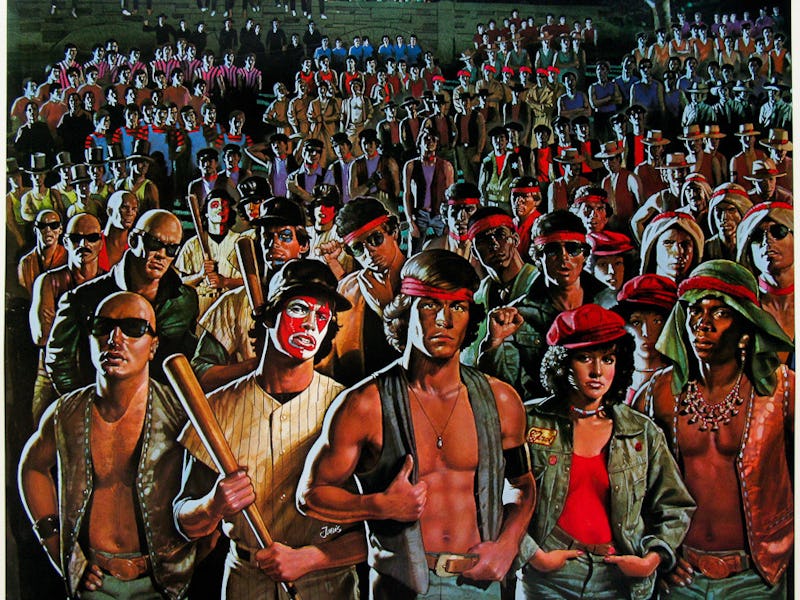'The Warriors' Is an Unheralded Brooklyn Classic
Can you dig it?

Of the genre classics of the late ‘70s and early ‘80s, The Warriors remains the most overlooked. Of the more celebrated semi-dystopian movies released around the same time — like John Carpenter’s Escape from New York — The Warriors uniquely presents a fully realized bizarro world whose steadfast vision of a depleted urban wilderness never lets up. In its naturalistic but endearingly cheesy production design, its comic book panel ethos, its appropriation of Western tropes, and its influence on video game structure, The Warriors deserves to be something more than just a cult classic — it’s a Brooklyn classic that romanticizes the borough that’s been unjustly caught in the cinematic shadow of its uptown counterpart, Manhattan, since, well, forever.
It’s surprising then that most of the action in The Warriors takes place in other boroughs, though the movie begins in Coney Island with a gorgeous neon shot of the iconic Wonder Wheel lit up at night. It’s an image that represents the broken but idealized home turf of the Warriors, a multi-ethnic and multi-personality gang of teen-to-twenty-somethings that are part of a Clockwork Orange-esque network of gangs that rule particular areas of the city and commit ultraviolence.
They’re soon torn from Brooklyn to the Bronx’s Van Cortland Park for an immense summit truce led by the most powerful gang leader in town, Cyrus. He implores the 100,000 hilariously themed gang members (some wear unkempt army fatigues, others wear face paint and baseball uniforms or unwashed overalls; our heroes wear red leather vests festooned with Native American symbology) around the city to join forces and rule New York.
A gang rival brutally murders Cyrus, blames the Warriors for the deed, and our hapless group is sent on the run through the city to make it back to Coney Island before other gangs can kill them for their alleged wrongdoing. What happens over the rest of the runtime is pure genre bliss.
If we’re talking about Brooklyn status let’s put aside almost the entire oeuvre of Spike Lee for a second. As the unofficial bard of Brooklyn, he borders on trying way too hard despite making some all-time greats, and once he’s outside of his comfort zone you get the sense that he doesn’t really have anything to offer on the same level. There are still other Brooklyn-centric movies that fit the bill — Dog Day Afternoon is an outright masterpiece, and the more recent films of Queens-born director James Gray have well documented the plight of the outer boroughs, but no other movie captures the intense appreciation for a specific Brooklyn location like The Warriors.
The movie’s heightened reality is surprisingly similar to gritty New York movies like Taxi Driver that were influential in defining the city around the time. The New York of The Warriors is dank and dirty, full of rampant crime and free from nearly any residents or potentially iconic locales that could be ruined by touristic infestation — the ‘70s were a different Gotham.
Only The Warriors roughly distills that decay into its premise and uses it as the movie’s main thrust. They do a lot of running and a lot of fighting against faceless cops and other gangs to get to the next subway stop closer to their home, or in video game parlance, the next level.
Brooklyn at large and Coney Island in particular may be gross and depraved, beset by garbage-ridden streets and tagged subway cars, but they’ll defend themselves and their territory at the highest cost to get there by any means necessary. It’s mythologizing borough-ism at its exploitative finest.
Once the Warriors do finally make it back to Coney Island — after battling countless bands of skinheads, orphans, and evil caricatured lesbians — they’re rightfully exhausted. “This is what we fought all night to get back to?” Swan, the leader of the Warriors says, dejected. He and the rest of the gang still have to face off against the Rogues, the gang that murdered Cyrus and put them in this whole mess to begin with. But they don’t do it out of fear or retaliation for Cyrus’ death. They do it out of simple, earnest pride.
When the factions are face-to-face, ready to rumble on the south Brooklyn beach like in some twisted, stylized war movie, Swan says, “When we see the ocean we figure we’re home, we’re safe.” They (spoilers) end up not squaring off, saved by Cyrus’ former gang, the Riffs, who find out the truth. But the woefully outnumbered Warriors were about to scrap to the death because, well, that’s what they needed to do to protect their home, to hold down their turf. Instead of certain death they get to triumphantly strut down the beach. “You Warriors are good. Real good,” says the head of the Riffs. As if they didn’t know.
Rumblings of a potential remake of The Warriors have come and gone over the years. Director Tony Scott was gearing up for his take on the story before his death in 2012, while just a few days ago the wacko auteurs Neveldine and Taylor, who spawned the onscreen embodiment of energy-drink consumption that is the Crank series, proudly said they’d love to get their hands on the rights to the remake. Fittingly enough, it was also made into a video game in 2005. But until a new iteration gets made the original remains one of a kind, a gritty and defiant Brooklyn classic.